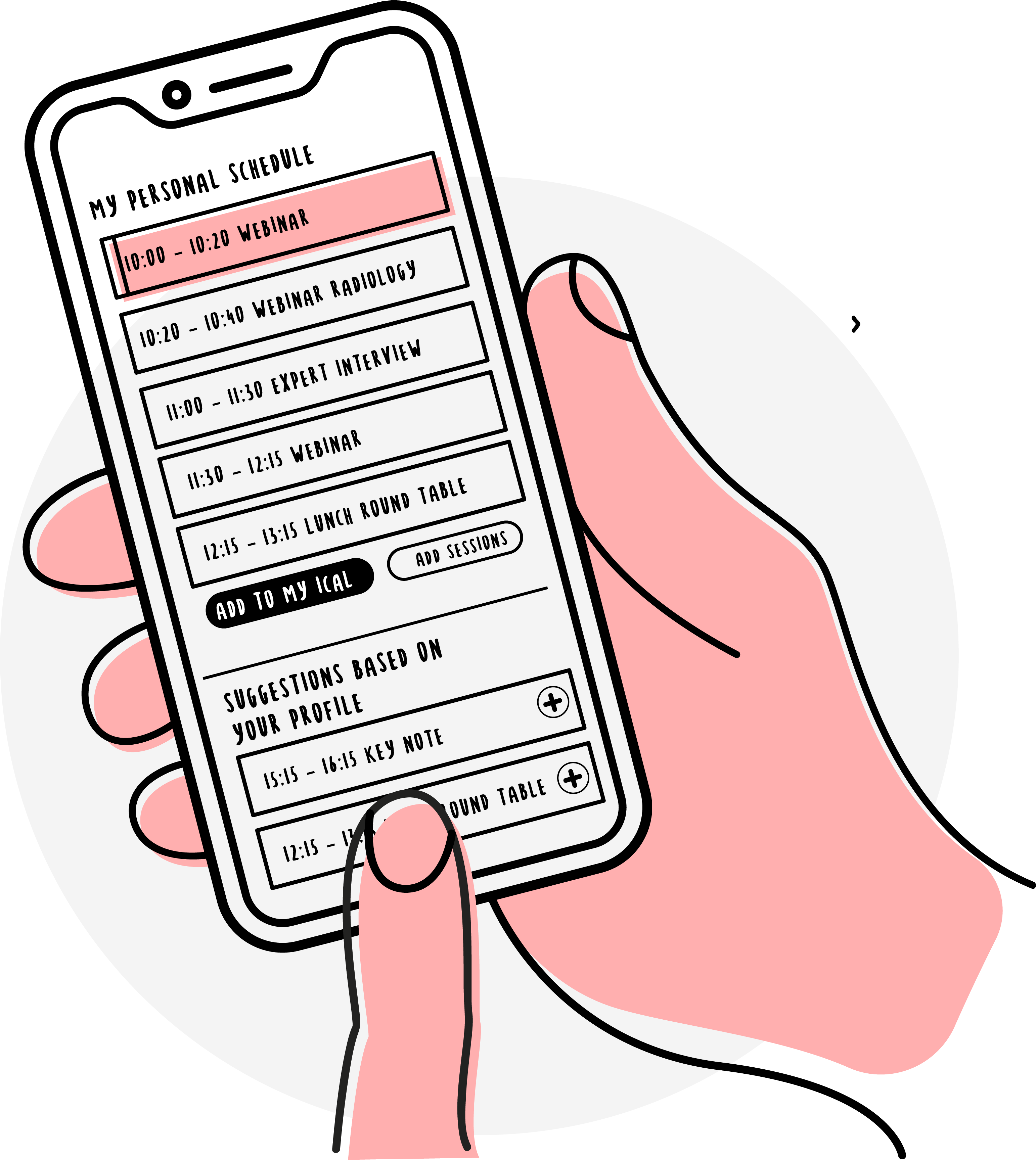This resulted in a big decrease in the quality of the experience for the people attending those events. Have you attended a virtual trade show lately? Or an online B2B event? We did, and for many of them it feels like going back to the early 2000s.
Among the companies struggling through this change, there was a large organization selling expensive equipment to other businesses. We helped them rethink how to run virtual events globally and with this article, we want to share our most important learnings with you.
A Case for Virtual Events
 According to Market Research Media, virtual events will grow from $14 billion in 2018 to $18 billion in 2023, with a steady increase of five percent annually. The opportunity is so big that over 90% of marketers plan to invest in virtual events, as we move forward to 2021. (Bizzabo, 2020)
According to Market Research Media, virtual events will grow from $14 billion in 2018 to $18 billion in 2023, with a steady increase of five percent annually. The opportunity is so big that over 90% of marketers plan to invest in virtual events, as we move forward to 2021. (Bizzabo, 2020)
However, do virtual events deserve the hype that seems to surround them?
Looking beyond Covid-19, virtual events have numerous advantages when compared to their physical counterparts. Marketing Insider Group listed several of them:
- Open up event attendance from any part of the globe
- Significant reduction in cost and event logistics
- Ease of collaboration and feedback mechanisms
- Extension of event content life cycle
- Efficient lead tracking and capturing
- Extended opportunity for driving ROI, via pre-records and on-demand content
- Convenience and flexibility for the attendees
- Easier access to quality speakers and contributors
- Significant reduction in carbon footprint
For new businesses that are trying to market their products, those are all very good reasons for investing in virtual events. However, what if you’re part of a large organization that is used to running offline events?
One of the most common questions that we heard during our project was:
‘Are online events likely to replace offline conferences?’
We believe that it’s very unlikely, and it will continue to be so as long as the following barriers exist.
The Attendee Barriers to Virtual Events
 From the perspective of the attendees, online events can be summarized as a substitute for physical experiences. Even with a lot of preparation, organizers are not able to replace the experience of entering an event space, speaking to people in person, eating nice food, collecting goodies, trying out a new product, going out for dinner, breathing the air of a city you’ve not been before and if you’re lucky, getting all of that paid by your company.
From the perspective of the attendees, online events can be summarized as a substitute for physical experiences. Even with a lot of preparation, organizers are not able to replace the experience of entering an event space, speaking to people in person, eating nice food, collecting goodies, trying out a new product, going out for dinner, breathing the air of a city you’ve not been before and if you’re lucky, getting all of that paid by your company.
To put it simply, offline events have the advantage of addressing all your physical senses to craft an experience that feels special, whereas virtual events can speak to a maximum of 2 or 3 senses.
To add on that, one of the core benefits of physical events is meeting other people face to face and sharing experiences with them. In every recurring conference, be it Adobe Summit or Dreamforce, there are tight-knit groups of attendees who know each other and that come every year. They’re the ‘recurring customers’ for event organizers, and they play an important role in influencing others to join the event as well.
For those people, the value of the event is about the connections and friendships that are built from one keynote to the other. These ‘regulars’ are the lifeblood of conferences, quite literally their organic engine of growth. As you might have already experienced, the whole networking and socializing part of offline conferences are completely gone in a virtual environment. There simply is no effective alternative to it.
Companies like Grip are trying to solve the networking challenge, but the experience is just not the same. At best, it feels like going through a series of online meetings and at worst, it’s like being popular on Tinder. Hordes of strangers and salespeople ping you hoping to jump on a call. C-level readers will understand this issue very well.
Finally, offline events do not suffer from videocall fatigue. An audience can easily see keynotes for a whole day if it’s in a physical location. Doing the same via video call is almost impossible. People will inevitably multitask or drop off.
The Sponsor Barriers to Virtual Events
So far, we’ve talked about the attendee experience, but that’s only one side of the coin.
If we want to understand the challenges that large businesses face on the topic of virtual events, we need to understand how offline events work and the role of sponsoring. To do so, let’s take a detour and take a look at trade shows and conferences, which are they main type of physical events that large businesses engage with.
It often surprises people to learn that in trade shows, organizers make the majority of the money from exhibitors and sponsors.
Just how much money, though? Let’s take the case of Informa, the 7,500 person conglomerate that owns dozens of trade publications and events.
Trends.co dived into Informa’s 2018 earnings deck, and they found that its revenue was $3.09B. Global exhibitions revenue was $761m, so they made 25% of company revenue just from running events.
In such an environment, what are the chances of digital replacing its physical alternative? We think they are slim, and it’s not only because of the issues with networking.
Landing pages and online ads are great tools to acquire new customers for many businesses. However, it would be childish to think that they are the right solution for every industry. When Volkswagen wants to buy millions of euros worth of machinery, a webinar is not sufficient. Its people will likely want to see the product in person and meet the suppliers.
At the end of the day, people do business with other people, and the best event organizers know it. They target companies that spend huge amounts of money on products and want to see those products in person. If an exhibitor can meet 3-5 potential customers and one of those customers spends 100k+ with them, a trade show can easily justify a €10k booth.
 So, how does all of this relate to virtual events and how can you take action from it? If we assume that the challenges outlined before won’t disappear, it becomes obvious that we should design for hybrid event experiences. By that we mean, aiming to complement offline conferences with digital solutions, instead of replacing them.
So, how does all of this relate to virtual events and how can you take action from it? If we assume that the challenges outlined before won’t disappear, it becomes obvious that we should design for hybrid event experiences. By that we mean, aiming to complement offline conferences with digital solutions, instead of replacing them.
A solution like that would allow your business to capture value from events even when:
- The attendees cannot travel to the event location
- The guest speakers cannot travel to your event location
- You are not able to deliver the experience physically for any reason
- You need to have a presence in multiple locations and time zones during the same day
- You want to re-use the content of the event with minimal marginal cost
Unfortunately, for most businesses a solution like this is 3 to 5 years ahead of their capabilities. Why? Because we need to question most of the things that are not working in virtual events today. Let’s look at the challenges that would need to be tackled.
Challenging the Norms of Virtual Events
There are two patterns that severely limit the experience quality of virtual events. We’ve seen this happen across industries and company size.
Firstly, right now a virtual conference is essentially a series of back to back webinars. The experience inevitably comes across as impersonal, and the lack of direct interaction with you as a viewer makes it way too tempting to open up another tab and do something else while the speaker is presenting.
To put it simply, organizers approach virtual events with the same mindset as if they were an offline experience.
Secondly, if you want to join a virtual event, you often need a computer to do so and you need to stare at it for the whole length of the event. Unfortunately, the technology powering most events does not allow you to join from mobile devices and when it does, the organizers don’t plan for it yet.
In other words, the experience of a virtual event is not adaptive at all to the lifestyle of most people. If participants don’t travel to a venue, they also won’t take time off to attend an event, and instead they’ll try to squeeze it between their daily tasks. If they did travel to a venue, but for any reason they cannot attend one of the activities, they still deserve to enjoy the content in a format that allows them to move around the venue.
In situations like that, the very meaning of ‘live event’ should change. On demand video, podcasts and articles already allow us to consume information whenever fits us best. Why can’t virtual events follow a similar approach? For the companies willing to explore concepts of ‘asynchronous experiences’, there might be very interesting upsides and opportunities for differentiation.
In the chapter below, you’ll see what an experience could look like, that addresses all of these issues. Feel free to take it and inspire your colleagues to re-think your approach to business events. If you’re curious to learn about how we can adapt this experience to your own busines, look me up on LinkedIn.
The Future of Hybrid Events
This is a story about Elisabeth, she is the head of the engineering at her company. She is looking for solutions that help her team to solve tough problems, while ensuring that the operations in her department are running smoothly.
Before the event >

Getting the attention
Elisabeth sees an ad on her social media and lands on the event landing page of your organization. This could either be for a trade show or for a company led event. The landing page shows clearly why she should join and what she can expect from the event.

Registering made easy
She signs up for the event using a simple registration form. Just a few personal details are required to provide at this stage as her profile will be built up over time as she interacts with the event and signs up to activities.

Smooth onboarding
She is welcomed by a virtual host (chatbot) that explains what to expect and asks a few questions to personalize the experience. After answering the questions, she browses the personalized content on the homepage. If the event requires her to pay a ticket, this is where the virtual host introduces the different packages available.
Creating her own event program 
She compiles her schedule for the event. She selects a few webinars, keynotes, product demos, one-on-ones, and workshops to her schedule and adds them to the calendar.
After doing that, she already checks out some of the available on-demand content that caught her attention while looking at the program.

Keeping it top of mind
She receives a set of emails that increase anticipation for the event. The emails consolidate the webinars' reminders and announce new speakers, news, invites for exclusive breakouts, etc.
During the event >
Entering the event
Elisabeth has blocked some time in her agenda, and she navigates to the event platform. After logging in, the host welcomes her back in a personal way. She sees in her schedule that her first keynote starts in 5 minutes. If she is attending the event in person, the host can guide her by showing where in the venue the next activity is happening.

Making best use of the available time
Because she has some time left before the keynote starts, the host suggests checking out some of the short form content that fits her preferences. This allows her to make the best use of her time between sessions.
Participating in the event
She enjoys the program and actively participates in the interactive sessions. At the end of each session, she rates and provides feedback to the speaker.

Missing out on a session
Unfortunately, she misses one of the sessions because of some urgent work matters. Luckily, the session is soon available for watching it on-demand.
Taking next steps 
After she's finished all her sessions, she's presented a few clear call-to-actions to wrap up the event. She decided to book a remote live demo of one of the products with a solution specialist from your company.
After the event >

Wrapping up
The same evening, Elisabeth gets an email that presents her with a nice summary of the event. It includes recordings of all her sessions, credits earned, a link to another session that could be relevant, etc.
Inviting her and her team
She receives an email from a sales rep with the invite for a virtual live demo. He has tailored this email to Elisabeth's needs, using data and insights gathered throughout the event. She forwards the mail to the rest of her team.

Account based marketing
Leading up to the solution demo, Elisabeth and her colleagues see relevant and targeted pieces of content on their social media channels.
Demo time
One week after the event, Elisabeth and other stakeholders join the solution demo via video call. The well-informed salesperson provides a compelling story, catered to all the needs of his audience.

On to the next…
A few months later, she receives a personalized message that guides her to the next best step, based on her profile and previously collected data.
How to Build it
If you’re an incumbent business, some of the features and touchpoints presented in this article might feel like a huge commitment. You might need to find a way for your tools to communicate with each other or maybe even replace some of the software solutions altogether. That was the case for our client.
However, before you start thinking about all the technical and political implications of doing something like this, we recommend validating the whole concept for your specific business and clients. Every reality is different and what worked well for our client might not work for you.
What’s the most cost-efficient way to do that? We recommend you run a custom design sprint in which you:
- Interview your customers on their relationship with online events and why they participate in business events. Find out what they’re looking for and why.
- Prototype the experience in low-fidelity and test it with your target audience
- Validate whether re-designing your event experience will indeed lead to the business impact you are looking for.
The last point is particularly important, especially for the people in your organization who have to sign off the budget. Luckily, you can easily do that through a combination of desk research, external interviews and marketing experiments.
If you need help in running these activities or you’re curious to hear more about how we craft great digital experiences, don’t hesitate to get in touch with us!




